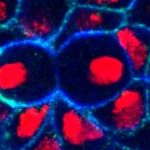Link to Pubmed [PMID] – 10673509
Genes Dev. 2000 Feb;14(3):377-88
Notch signal transduction appears to involve the ligand-induced intracellular processing of Notch, and the formation of a processed Notch-Suppressor of Hairless complex that binds DNA and activates the transcription of Notch target genes. This suggests that loss of either Notch or Su(H) activities should lead to similar cell fate changes. However, previous data indicate that, in the Drosophila blastoderm embryo, mesectoderm specification requires Notch but not Su(H) activity. The determination of the mesectodermal fate is specified by Single-minded (Sim), a transcription factor expressed in a single row of cells abutting the mesoderm. The molecular mechanisms by which the dorsoventral gradient of nuclear Dorsal establishes the single-cell wide territory of sim expression are not fully understood. We have found that Notch activity is required for sim expression in cellularizing embryos. In contrast, at this stage, Su(H) has a dual function. Su(H) activity was required to up-regulate sim expression in the mesectoderm, and to prevent the ectopic expression of sim dorsally in the neuroectoderm. We have shown that repression of sim transcription by Su(H) is direct and independent of Notch activity. Conversely, activation of sim transcription by Notch requires the Su(H)-binding sites. Thus, Notch signalling appears to relieve the repression exerted by Su(H) and to up-regulate sim transcription in the mesectoderm. We propose a model in which repression by Su(H) and derepression by Notch are essential to allow for the definition of a single row of mesectodermal cells in the blastoderm embryo.

